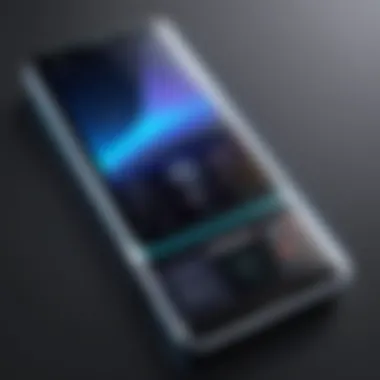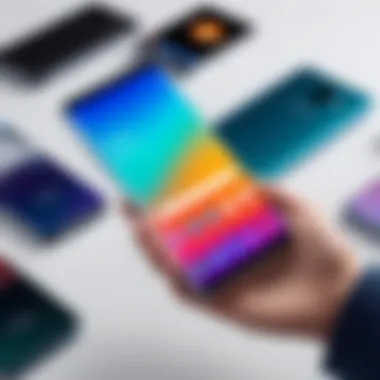Samsung's Concept Phone Innovation: A New Era


Intro
As technology progresses, the way we interact with it evolves. Samsung, as a leader in mobile innovation, has been at the forefront of this evolution. Its concept phones represent more than just prototypes; they offer a glimpse into the future of mobile technology. This article will explore the multifaceted journey of Samsung in conceptualizing and developing these devices. From initial ideas to market implications, the discussion will illuminate how Samsung is shaping the future of smartphones.
Overview of the Technology
Key specifications
Samsung’s concept phones often showcase cutting-edge features that are yet to be seen in mainstream devices. These can include advanced display technologies, unique camera configurations, and innovative battery solutions. For instance, the Samsung Galaxy Z Fold series highlights foldable screen technology that transforms user interaction by integrating larger displays into compact devices.
Another example includes concepts with integrated AI capabilities, enabling more intuitive user experiences. With features like real-time translation, enhanced photography modes, and personalized assistant functionalities, these specifications set the stage for a new era in mobile tech.
Unique selling points
Samsung’s concept phones stand out due to their bold experimentation and design. These devices are crafted with a vision. For example, the Samsung S Pen integration in its Galaxy devices has revolutionized productivity on mobile phones, merging traditional note-taking with digital convenience. Furthermore, features like multitasking capabilities and seamless app transitions offer practical benefits that appeal to both casual and professional users.
"Innovative design goes hand-in-hand with technological advancement. Samsung's concept phones not only reflect what is possible but also anticipate consumer needs."
Design and Build Quality
Material used
In the pursuit of innovation, Samsung often employs materials that enhance both aesthetics and functionality. High-grade aluminum and glass are standard, providing durability while keeping the device lightweight. The use of materials like Gorilla Glass has become prominent in their devices, ensuring resistance to scratches and drops. In some concept models, even biodegradable materials are being explored, indicating a commitment to sustainability.
Ergonomics and usability
Designing a concept phone is not solely about looks. Samsung emphasizes usability and ergonomics. Curved edges and placement of buttons are meticulously planned to offer comfort during prolonged use. The balance between form and function is evident in designs that prioritize user experience. In addition, with foldable models, Samsung has ushered in a new form factor that aligns with modern lifestyles, allowing users to carry a tablet-sized screen in their pocket.
Epilogue
In essence, Samsung’s journey in concept phone innovation is both exciting and reflective of the dynamic nature of the tech industry. By combining cutting-edge technology with thoughtful design, Samsung continues to push the boundaries of what is conceivable in mobile communication. The insights gained from these innovations not only inform future products but also influence the entire smartphone market, setting new standards for functionality and style.
Foreword to Samsung's Concept Phones
Samsung has spent years at the forefront of mobile technology, constantly pushing the intersection of engineering and design. The company's concept phones represent not just a glimpse into potential future products but a critical part of their innovation strategy. Understanding Samsung's approach to concept phones offers insights into how the technology landscape might evolve, reflecting shifting consumer demands and advancing technologies.
Understanding the Concept of Concept Phones
Concept phones are prototypes designed to showcase ideas, functionality, and new technologies. These devices are not typically intended for commercial sale but serve several important purposes. They allow developers and designers to experiment with features that might not yet be feasible for consumer markets. In this context, Samsung's concept phones are crucial for visualizing what the next generation of mobile devices could look like.
Investing in concept phones enables Samsung to gather early feedback on innovative designs and functionalities. This feedback loop can inform the development of future devices, ensuring that they align with user preferences. Concept phones also allow companies to maintain a competitive edge by positioning themselves as leaders in tech innovation. By embracing this developmental stage, Samsung effectively bridges the gap between theoretical innovation and practical application, shaping how consumer electronics evolve.
The Role of Concept Phones in Innovation
Concept phones play a significant role in innovation for several reasons. First, they act as a testing ground for groundbreaking technologies, facilitating advancements that might previously have seemed unattainable. For example, features like flexible displays and foldable screens emerged from such innovations, significantly changing the design of smartphones.
Moreover, showcasing these prototypes generates interest and excitement in the consumer market. People often look forward to new technologies, and concept phones can leverage social media and tech news cycles to create buzz. The anticipation built around such releases can set the stage for commercial products by establishing consumer expectations ahead of time.
In addition, concept phones help foster collaboration among designers, engineers, and marketers. These teams can engage directly with devices that explore uncharted territory, sharpening their focus on consumer needs and technological possibilities. Ultimately, concept phones serve as a vital infrastructure of innovation, enhancing the overall development ecosystem while allowing Samsung to stay ahead in the competitive mobile landscape.
Overall, Samsung's concept phones are not merely experimental devices; they are crucial instruments of future-oriented thinking and innovation in technology.
Design Philosophy Behind Concept Phones
The design philosophy behind concept phones significantly influences their perceived value and market viability. Concept phones serve as a canvas for innovation, showcasing not only technological advancements but also the aesthetic and functional principles that guide their creation. Samsung's approach involves a thoughtful fusion of ergonomics, material selection, and visual appeal. This interplay impacts consumer perception and ultimately drives trends in the mobile industry.
Aesthetic Considerations
Aesthetic considerations play a crucial role in the development of concept phones. Samsung aims to create devices that are visually striking and align with contemporary design trends. This involves intricate attention to detail, form factors, and color schemes. The overall design does not merely aim to attract consumers; it reflects a vision of the future of mobile technology.
- Color Schemes: Vibrant colors or subtle hues can create a strong emotional connection.
- Form Factors: Unique shapes and styles engage users visually and physically.
- Finishing Touches: Premium coatings and finishes convey a sense of luxury and modernity.


The initial impressions often dictate consumer interest. Therefore, Samsung’s focus on aesthetics helps bridge the gap between practical use and desirable art.
Ergonomics and Usability
Ergonomics and usability are integral to Samsung’s concept phone designs. While striking visuals attract attention, the usability of these devices dictates their practicality in day-to-day life. Samsung pays close attention to how users interact with devices. Every curve, button placement, and screen size matters. The goal is to ensure that each device fits naturally into the user's hand and lifestyle.
- Button Placement: Correctly positioning buttons improves access and reduces frustration.
- Screen Size: Sizing screens for comfort while maintaining functionality matters.
- Weight Distribution: Balancing the weight of the device contributes to comfort during extended use.
Ultimately, an ergonomic design can make the difference between a product that is merely interesting and one that merges seamlessly with users' lives.
Integration of Materials and Textures
Integrating materials and textures is a hallmark of Samsung's design philosophy. The physical feel of a device can significantly impact user experience. Various materials such as glass, metal, and innovative polymers are tested for not just aesthetic quality but also tactile response. This leads to a richer interaction between the device and the user.
- Material Choices: Metals could suggest durability, while glass might offer elegance.
- Texturing: Smooth versus textured surfaces can influence grip and comfort.
- Durability vs. Aesthetics: Finding the balance ensures the product withstands usage while appearing appealing.
The right combination of materials and textures not only enhances the device's look but also its functional properties, creating an experience that resonates well with users.
"A well-designed concept phone is not just a tool; it is a statement of technological ambition and personal style."
In summary, the design philosophy underlying Samsung's concept phones is multifaceted. Aesthetics, usability, and material integration all contribute to making a cohesive product. Understanding these principles helps illuminate the complexities involved in advancing mobile technology into the future.
Technological Innovations in Samsung's Concept Phones
The exploration of technological innovations within Samsung's concept phones reveals a critical aspect of the brand's strategy in shaping the future of mobile devices. These innovations are not merely for show; they often serve a dual function of showcasing potential capabilities while also addressing real user needs. As technology continues to evolve, staying ahead in this competitive landscape requires much more than just incremental improvements. It necessitates bold steps, unique insights, and a clear understanding of what consumers desire.
Display Technology Advances
One of the most significant areas of innovation in Samsung's concept phones is display technology. Samsung has pioneered several advancements that enhance the visual experience provided by mobile devices. This includes developments like the Infinity Display and OLED technology, which provide vivid colors and deeper contrasts. The flexibility of OLED screens enables the creation of foldable devices, which blend portability with usability. This combination has proven appealing to consumers seeking devices that do not compromise on screen real estate.
Moreover, the exploration of devices with under-display cameras and sensors elevates the aesthetics and functionality. This design minimizes interruptions on the display, thus fostering a seamless viewing experience. Such innovations position Samsung at the forefront of display technology evolution, enabling them to meet both aesthetic and practical consumer expectations.
Camera Innovations
Camera technology is another cornerstone of Samsung's concept phone innovations. Every new iteration appears to go above and beyond its predecessor, aiming to deliver exceptional photo quality and usability. Innovations like improved autofocus mechanisms, enhanced low-light performance, and multi-lens systems showcase the brand's commitment to pushing boundaries.
Additionally, features like AI enhancements in photo processing enable users to capture professional-grade images with ease. Depth sensors that allow for sophisticated portrait effects are now standard in many concept designs. This focus aligns with a growing consumer demand for high-quality content creation tools in their phones, merging functionality with lifestyle needs.
Samsung’s experiments with alternative forms, such as retractable or rotating cameras, further exhibit creativity in design while enhancing practicality.
Battery and Charging Developments
As smartphones grow more capable, battery life becomes increasingly relevant. It stands to reason that technological innovations in battery and charging systems are integral to Samsung's concept phones. Advances in battery technology aim to provide longer usage times without compromising device thickness or weight.
Quick charging solutions, including wireless technologies, reflect a response to the fast-paced lifestyle of modern consumers. Samsung's exploration of superfast charging solutions seeks to address the problem of downtime as users expect to charge devices more efficiently. Moreover, energy-saving modes and adaptive power management systems play a key role in enhancing battery performance, making these innovations vital to the overall consumer experience.
Market Implications of Concept Phones
Concept phones, specifically those developed by Samsung, serve as crucial indicators of market dynamics and consumer behavior. These devices do not just represent futuristic innovations, but they also reflect significant trends in consumer expectation and the competitive landscape in the mobile technology sector. Understanding the market implications means diving into how these factors contribute to shaping current and future technological developments.
Consumer Trends and Expectations
Today’s consumers exhibit a clear preference for devices that integrate seamlessly into their lives, emphasizing functionality and aesthetic appeal. The appetite for new features pushes companies, including Samsung, to innovate continuously. With concept phones, Samsung can test these consumer trends and expectations.
Key aspects influencing consumer behavior include:


- Customization: Users increasingly desire devices that can be tailored to their personal needs. Concept phones often showcase advanced customization options, suggesting a future where personal device interaction becomes more prevalent.
- Sustainability: Many consumers are becoming aware of environmental concerns. They expect brands to produce eco-friendly devices, leading Samsung to consider sustainable materials in their concept designs.
- Smart Integration: The rise of IoT means that consumers look for phones that can easily connect with other smart devices. Concept phones often explore enhanced connectivity features that may become standard in future releases.
The insights gained from consumer trends and sentiments ultimately help Samsung and other manufacturers tailor their products more effectively.
Competitive Landscape and Positioning
The competitive landscape in mobile technology is fierce, and concept phones enable Samsung to maintain its position as a leader. By introducing innovative concepts, Samsung sets benchmarks for competitors and garners media attention, generating significant buzz around their potential products.
Competitive positioning involves several strategic considerations:
- Differentiation: Concept phones allow Samsung to differentiate itself by exploring revolutionary ideas that competitors may not yet adopt.
- Market Leadership: By becoming the first to market advanced concepts, Samsung can establish itself as a thought leader in the industry.
- Collaborations: Samsung’s partnerships with tech developers enhance the capabilities of concept phones, which can offer unique functionalities absent from rival devices.
Understanding competitive dynamics informs Samsung’s overall strategy, guiding what innovations to pursue further based on market gaps identified through concept phone development.
Monetization Strategies and Profitability
While concept phones serve primarily as exploratory tools, they also play a role in refining monetization strategies that can lead to improved profitability in the core product lines. Here are some strategies:
- Feedback Loop: Through consumer trials of concept phones, Samsung gains valuable feedback that sharpens future designs, thus reducing costs associated with product launches.
- Brand Loyalty: Innovative concepts can foster brand loyalty as consumers seek to be associated with cutting-edge technology. This can translate into higher demand for future products, subsequently boosting sales.
- Limited Editions: Samsung can create exclusivity with limited-edition launches of certain concept phones, which can command higher price points, increasing revenue.
Ultimately, by focusing on strategic monetization, Samsung can create a robust financial model supporting ongoing innovation initiatives.
Concept phones are not just technological marvels; they are essential tools for understanding the market landscape, consumer preferences, and the pathways to future profitability.
The Consumer Response to Concept Phones
The consumer reaction to concept phones is vital in understanding the overall success and direction of these innovative devices. When Samsung unveils a new concept phone, it generates considerable interest and dialogue within the technology community. Consumers are not merely passive observers; their feedback directly influences design choices and future development. The perceived desirability of a concept phone can propel the brand's innovation strategy. Positive reactions can lead to heightened anticipation for the final product, while negative perceptions may drive revisements before any official launch.
A key aspect to consider is how users perceive functionality alongside innovation. Consumers often evaluate if new features are practical for everyday use. Early adopters tend to be more forgiving of flaws, provided that the technology demonstrates potential. They assess user interface intuitiveness and the tangible advantages that a concept phone can offer compared to existing models. This dynamic provides valuable data that Samsung can leverage in its design iterations.
User Feedback and Reviews
When a concept phone is debuted, feedback from users consists of initial impressions submitted through reviews and hands-on experiences. Reviewers often analyze features and share opinions on usability. These impressions can be instrumental in shaping perceptions.
Considerations often include elements like:
- Design: Is the phone aesthetically pleasing or does it push the boundaries too far?
- Feature Set: Are the innovations practical, or do they seem like gimmicks?
- Performance: Does the phone function smoothly under real-world conditions?
Constructive criticism from reviewers typically helps refine future prototypes. Manufacturers like Samsung often take these insights seriously, leading to design modifications or feature adjustments.
Social Media Impact on Perception
Social media acts as a major conduit for the dissemination of opinions on concept phones. Platforms like Reddit and Facebook serve as forums for discussion, where users share their thoughts, insights, and critiques. Viral posts can propel concept phones into the spotlight, creating buzz that far exceeds traditional advertising. This interaction can shape how concept phones are expressed in the public eye.
Key impacts include:
- Instant feedback loops that allow consumers to voice their opinions.
- The ability to spread both enthusiasm and disappointment rapidly.
- Social validation through likes, shares, and comments can influence stranger's views.
The conversation in social media can also identify trends that manufacturers may need to explore more deeply. It is clear that consumer feedback and social media interactions significantly affect how concept phones are perceived in the market.
Case Studies of Notable Samsung Concept Phones
The case studies of notable Samsung concept phones are critical in showcasing how Samsung has blended innovative design with practical technology to redefine the mobile experience. By analyzing these successful concepts, one can gain insights into the strategies used by Samsung to stay at the forefront of mobile technology.


Each case study serves as an illustration of Samsung's ability to anticipate trends and respond to consumer needs. Studying these phones can provide valuable lessons not just in product development, but in market positioning and consumer engagement.
Galaxy Fold Concept
The Galaxy Fold concept marked a pivotal point in smartphone design. When it first emerged, it introduced a folding screen technology that created a whole new category of devices. This model addressed several pain points of conventional smartphones, such as multi-tasking capabilities and screen real estate. With its unique folding mechanism, users could easily switch between a compact phone and a larger tablet experience.
The feedback from early users indicated a strong interest in the functionality it offered. Insights from these responses helped refine the technology, ensuring better durability and user experience upon its release. The Galaxy Fold exemplifies how concept phones can lead to practical innovations that significantly change how consumers interact with their devices.
Samsung Galaxy Zero
The Samsung Galaxy Zero concept took a bold step towards the vision of a truly bezel-less phone. This design eliminated the traditional frame, creating a screen that seemed to extend into infinity. The focus was on maximizing the display area while maintaining usability.
This concept faced challenges related to camera positioning and durability. However, it generated discussions about future design possibilities and user preferences. The idea of a seamless display resonated with many tech enthusiasts, indicating a shift toward more immersive technology. Initial responses from consumers reflected excitement at the thought of a phone that could break free from conventional design constraints.
Galaxy Concept
The Galaxy X concept further pushed the envelope of mobile technology with an emphasis on modular design. This phone idea allowed consumers to customize their devices based on personal needs and preferences. By enabling users to add or change components like the camera, battery, or storage, Samsung aimed to improve user satisfaction and longevity of the device.
Initial reactions showed a strong interest in the flexibility this design could provide. The concept highlighted not just the technological feasibility, but also the potential shifts in consumer expectations towards customization and personalization.
"The ability to tailor devices to individual needs could revolutionize how users relate to their smartphones."
Each case study emphasizes the evolution of Samsung's approach to concept phones, revealing not just technical innovation, but also how consumer insights shape future developments.
These notable concept phones demonstrate that the path to successful mobile device technology is paved with both ambitious designs and thoughtful consumer engagement.
Future Directions in Concept Phone Development
The realm of concept phones is crucial in the ongoing evolution of mobile technology. As companies like Samsung push the boundaries of what is possible, understanding the future directions in concept phone development becomes essential. This section will discuss emerging technologies and shifts in consumer expectations that are shaping the next generation of mobile devices. These elements not only influence the design and functionality of new devices, but also the overall strategy brands take in reaching their target audiences.
Emerging Technologies and Their Impact
Emerging technologies hold transformative potential for concept phones. Key advancements like foldable displays, artificial intelligence, and augmented reality are not just trends but pivotal elements in reframing user experience.
- Foldable Displays: The introduction of flexible screen technology allows for more compact designs without sacrificing screen real estate. As this technology matures, we can expect devices that can seamlessly transition from a phone to a tablet.
- Artificial Intelligence: AI integration enhances personalization. Devices will increasingly learn user habits and adjust settings automatically to improve usability. This trend could result in smarter devices that respond intuitively to their users.
- Augmented Reality: AR applications are expected to become more prevalent in daily mobile use. Incorporating AR can dramatically enhance how users interact with their environment through their devices, blurring lines between reality and digital overlays.
The benefits of these technologies are significant. They promise to improve device functionality, streamline interactions, and offer unique user experiences. However, it is crucial to also consider the development challenges, such as ensuring durability and battery life in these innovative designs.
Shifts in Consumer Behavior and Expectations
Consumer expectations are shifting dramatically as technology evolves. Today’s users seek devices that are not only functional but also adaptable to their lifestyle. This trend requires manufacturers to keep a close eye on behavioral changes.
- Sustainability: More consumers are prioritizing eco-friendly options. Brands are encouraged to incorporate sustainable materials and practices into production, setting an expectation for concept phones that align with environmental values.
- Customization: The demand for personalization is rising. Users now prefer devices that reflect their individual needs and preferences. This could lead to concept phones that offer customizable features, from hardware choices to software interfaces.
- Seamless Connectivity: Users now expect devices to work effortlessly with other technology. The integration of various ecosystems is becoming a priority, driving the development of phones that connect with smart home devices, wearables, and other platforms.
"Understanding shifting consumer expectations is essential for any tech company aiming to remain relevant in a fast-paced market."
In summary, the future of concept phones is leaning towards embracing these technological advancements and evolving consumer demands. Addressing these aspects will be vital for Samsung and others in the industry as they navigate the competitive landscape. The way forward will require a careful balance between innovation and practicality, ensuring that future devices are not only cutting-edge but also meet the needs and expectations of the end user.
Closure
The conclusion of this article underscores the critical insights garnered from the exploration of Samsung's concept phone innovations. It encapsulates the journey through design, technology, market forces, and consumer reactions, all of which are essential in understanding the full scope of this topic.
Recap of Key Takeaways
To summarize the key points discussed:
- Samsung's Design Philosophy: The aesthetic and functional considerations have greatly influenced the appeal of concept phones. These devices often reflect the brand's vision for the future.
- Technological Innovations: Display technology, camera features, and battery life have all seen significant advancements. These innovations do not only enhance user experience but also set benchmarks for the industry.
- Market Dynamics: Concept phones play a pivotal role in shaping consumer expectations. The feedback loop between users and manufacturers is critical in driving future designs and functionalities.
- Consumer Engagement: Social media platforms have been instrumental in gauging consumer interest and reactions toward new concepts, informing future developments.
The Future of Samsung's Contribution to Mobile Tech
Looking ahead, Samsung’s commitment to innovation in mobile technology is poised to redefine user experiences. The company has a unique opportunity to lead the industry by leveraging new technologies such as AI, augmented reality, and advanced materials. Understanding shifts in consumer behavior will further guide their strategies.







